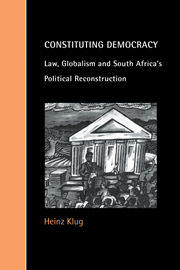Book contents
- Frontmatter
- Contents
- Acknowledgements
- Abbreviations
- Introduction
- 1 Post–Twentieth-Century Constitutionalism?
- 2 Legal Legacies and Constitutional Paths
- 3 Constitutionalism in Global Perspective
- 4 Constitutional Strategies
- 5 Constitutionalism in the Democratic Transition
- 6 Global Impact: International Imperatives and their Hybridization
- 7 The Constitutional Court and the Institutional Dynamics of Constitutionalism
- 8 Constitutional Imaginations and the Possibilities of Justice
- Conclusion
- Notes
- Bibliography
- Index
2 - Legal Legacies and Constitutional Paths
Published online by Cambridge University Press: 06 July 2010
- Frontmatter
- Contents
- Acknowledgements
- Abbreviations
- Introduction
- 1 Post–Twentieth-Century Constitutionalism?
- 2 Legal Legacies and Constitutional Paths
- 3 Constitutionalism in Global Perspective
- 4 Constitutional Strategies
- 5 Constitutionalism in the Democratic Transition
- 6 Global Impact: International Imperatives and their Hybridization
- 7 The Constitutional Court and the Institutional Dynamics of Constitutionalism
- 8 Constitutional Imaginations and the Possibilities of Justice
- Conclusion
- Notes
- Bibliography
- Index
Summary
A standard explanation for the shift to democratic constitutionalism, and the empowerment of courts it implies, in states emerging from dictatorships and social conflict is that the shift is a reaction to that society's particular past. While the rejection of tyranny and the embracing of rights may seem a logical consequence of their prior denial, this explanation does not explain why this should include a turn towards the judiciary as the ultimate protectors of such rights. This is particularly so when the judiciary and the law in general were intimately associated with the construction and maintenance of the prior oppressive regime.
As the history of English constitutionalism and until recently the legislatively enacted Bill of Rights in pre-1982 Canada demonstrate, there is no inherent link between the recognition and protection of rights and the empowerment of a judiciary to strike down laws passed by a democratically elected legislative majority. In the South African context judicial review of legislative authority had historically been explicitly rejected, and in the more recent past the major parties were committed to notions of democracy which assumed parliamentary sovereignty. This makes the turn in South Africa to a constitutionalism with a privileged judiciary not just seemingly unnecessary to goals of democratization, but downright puzzling.
The struggle against apartheid in South Africa was always understood as a struggle against racial oppression and minority rule, and conversely, as a struggle for democratic rights and majoritarian democracy.
- Type
- Chapter
- Information
- Constituting DemocracyLaw, Globalism and South Africa's Political Reconstruction, pp. 29 - 47Publisher: Cambridge University PressPrint publication year: 2000

